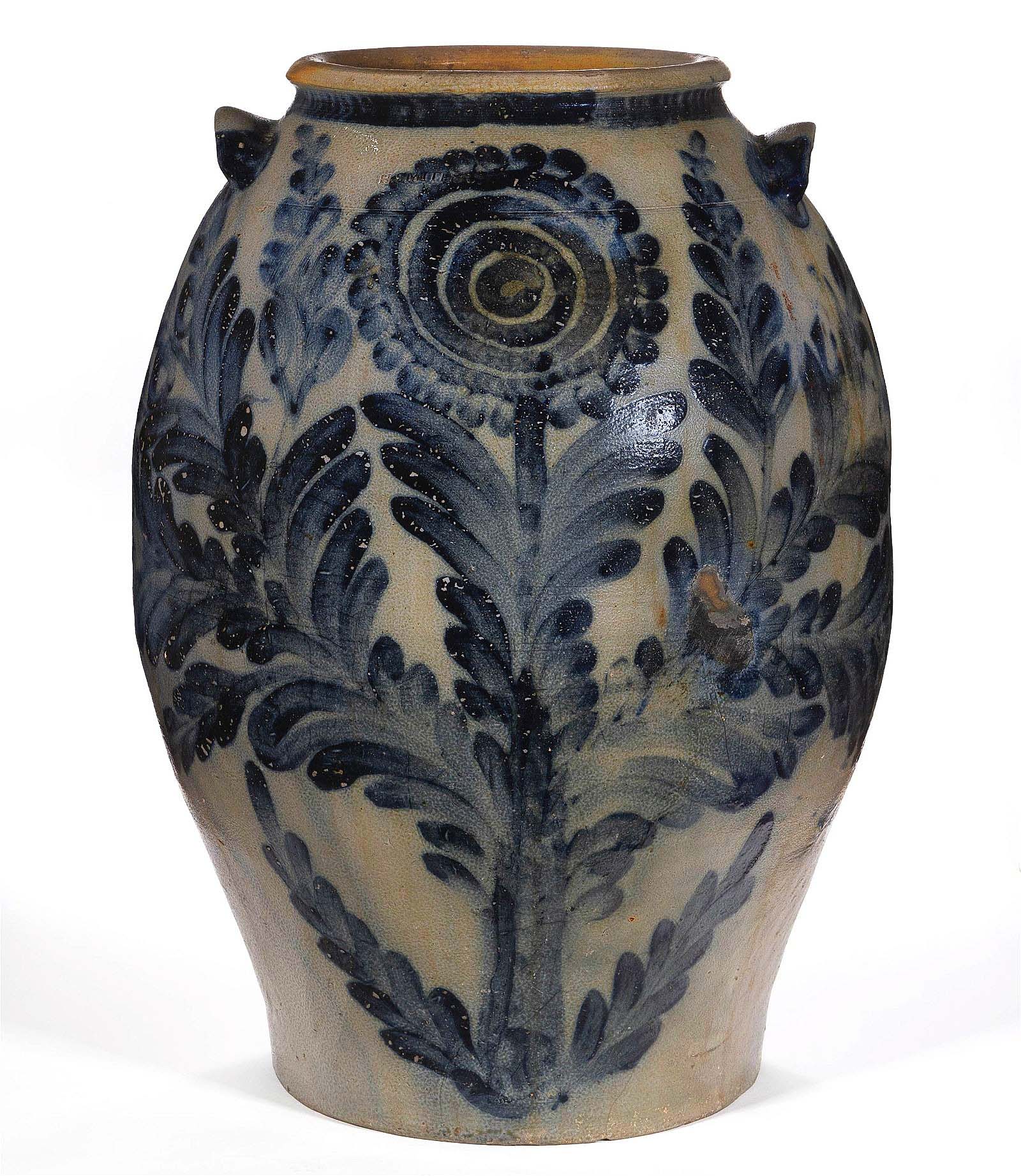
Leading the sale at $144,000 was this 10-gallon stoneware jar attributed to David Jarbour, stamped “H. Smith & Co.” for Hugh Smith/Wilkes Street Pottery, Alexandria, Va., circa 1830s, 20¾ inches tall ($80/120,000).
Review by Carly Timpson; Photos Courtesy Jeffrey S. Evans & Associates
MOUNT CRAWFORD, VA. — Across two days, Jeffrey S. Evans & Associates presented items from the collection of brothers Albert “Al” and William “Billy” Steidel from Alexandria, Va. The February 9 and 10 sale offered more than 1,050 lots of American folk pottery, including important Virginia and Washington DC stoneware; glass bottles and jars; country store items and advertising; American military material; Native American objects; and collectibles. Every lot in the sale successfully changed hands.
Company president and principal auctioneer Jeffrey S. Evans commented, “This sale generated strong interest across the board, from bidders near and far. The caliber of the material offered across multiple categories was very appealing to a broad swath of collectors. There were good crowds in-house on both days and levels of online participation in our auctions continue to grow — a real indication that there is sustained market demand for a diverse range of Americana, historical material and other collectibles. The overall excitement and strong sales results reflect the freshness and high quality of the merchandise offered.”
Outperforming all other lots was a circa 1830 10-gallon stoneware jar from Alexandria, Va. This historic jar was attributed to David Jarbour, a once-enslaved African American who purchased his freedom in 1820. The cobalt-decorated jar featured a focal sunflower illustration with leafy patterns flowing toward the reverse where the surface was almost completely covered with three-leaf “turkey-foot” ornaments. With two “H. Smith & Co.” stamps for Hugh Smith of Wilkes Street Pottery, this large jar was cataloged as “one of the most highly developed examples of stoneware by an identified African American potter recorded thus far.” A major East Coast institution bidding over the phone purchased the historical piece for $144,000.
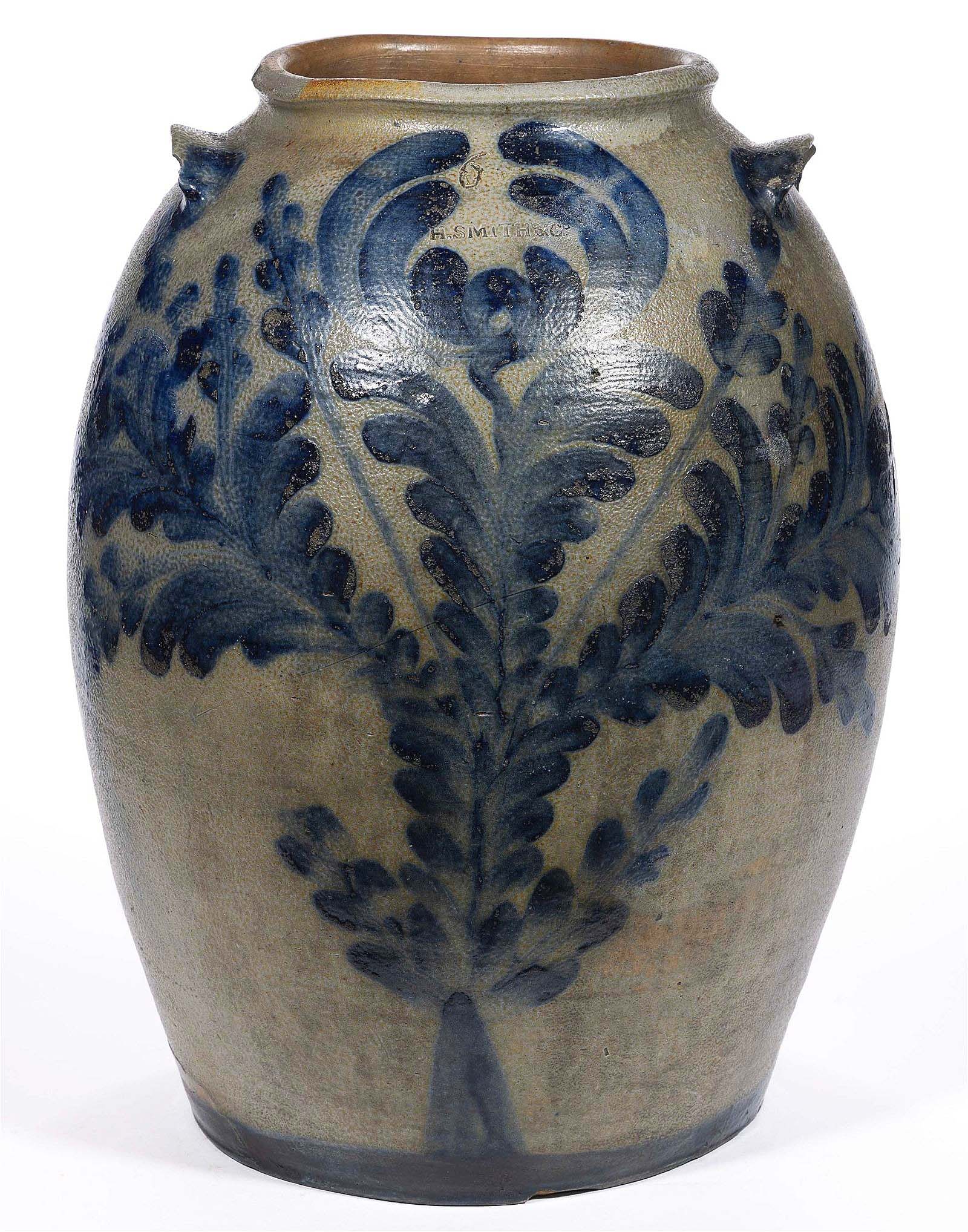
Exceeding its $2/3,000 estimates to achieve $19,200 was this 6-gallon jar marked “H. Smith & Co.,” possibly David Jarbour for Wilkes Street Pottery, Alexandria, Va., circa 1822-30, 17-3/8 by 7½ inches.
Other stoneware likely by David Jarbour also found success in the sale. One such piece exceeded its $2/3,000 estimate to achieve $19,200. Stamped “H. Smith & Co.,” this 6-gallon jar featured an elaborate cobalt floral decoration, including a central stem with leafy branches extending around to the sides of the body. While not being marked for Jarbour, the floral decorations are nearly identical to those on his confirmed pieces. A solid cobalt band circled the base of the jar and more blue markings accented the applied handles.
An early Nineteenth Century pitcher from Wilkes Street founder John Blake Swann, circa 1819-21, went out at $5,228. Stamped “J. Swann” the 2-gallon pitcher was 12¾ inches tall and decorated with brushed cobalt flower and tassel ornaments in addition to its solid and foliate bands on the neck. Also generating respect from bidders was a pitcher stamped “H.C. Smith” for Hugh Charles Smith (active 1847-1850). This 5-inch-tall pitcher had a 3-gallon mark and was decorated with a traditional cobalt Alexandria flower motif, characterized by a central round flower and “dabbed” or brushed leaves. The H.C. Smith pitcher realized $10,455.
The next and final owner of the company, Benedict C. Milburn, was represented among the highest-earning lots by two very different pieces. The first was a 5-gallon water cooler, measuring 16½ inches tall and the other was a round pan, which was not even 4 inches high. The water cooler was described in the auction catalog as being of “cylindrical form with slight shoulder, squared rim, collared neck, vertical open handles and octagonal-shaped bunghole.” The water cooler brought $15,600. Rounding out the top 16 lots was a half-gallon conical-form stoneware pan with a pour spout. It was decorated with a cobalt flower beneath the spout and nine other blossoms in a ring around the pan. Shooting past its $500/800 estimate, it realized $4,613.
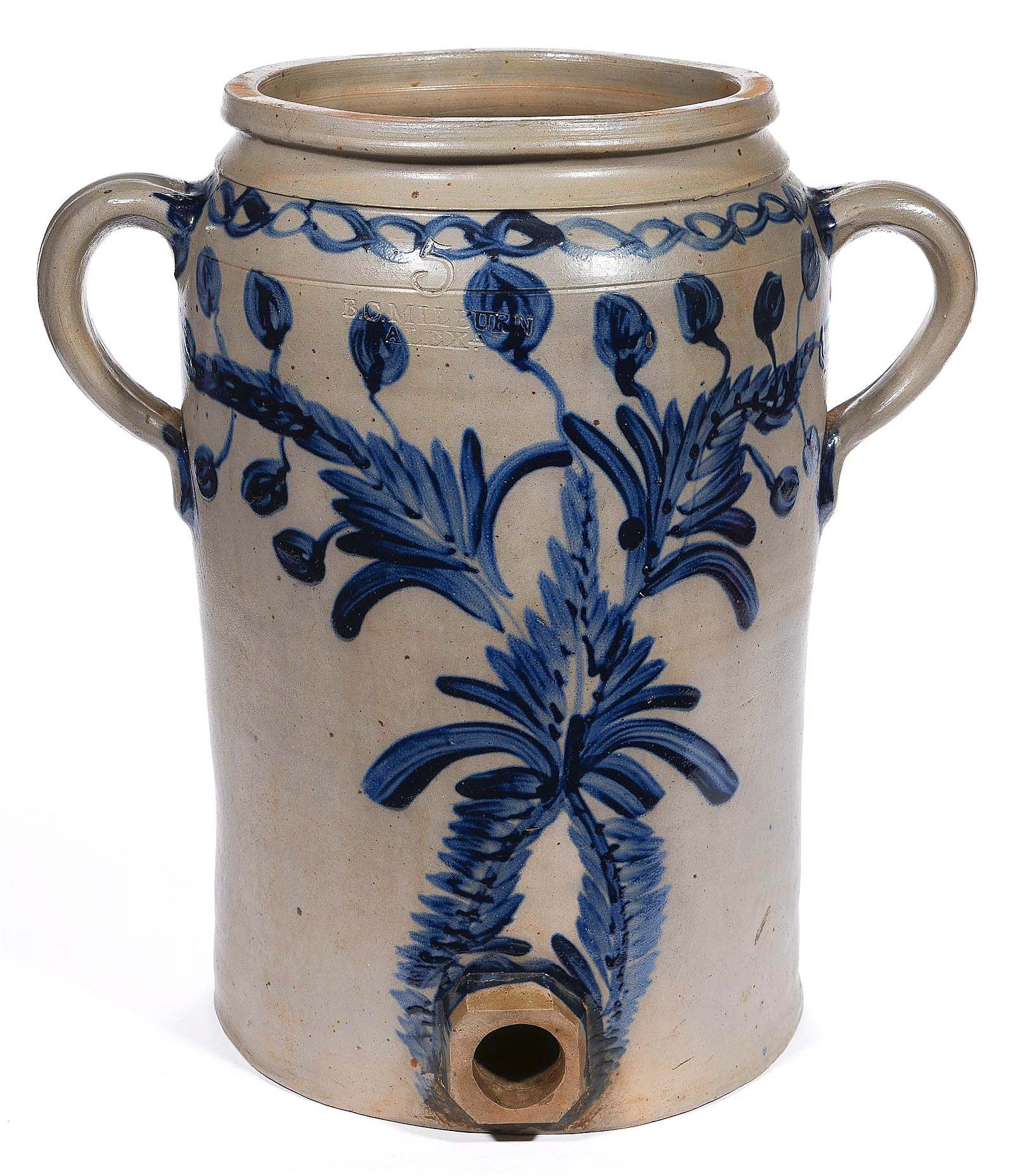
A 5-gallon stoneware water cooler stamped for Benedict Cuthbert Milburn/Wilkes Street Pottery, Alexandria, Va., circa 1841-67, 16½ by 9½ inches, finished at $15,600 ($10/15,000).
Two pieces of stoneware that were not from Wilkes Street Pottery made an impact on bidders as well. One, likely from Timberville, Va., was an approximately 2-gallon ovoid-form pitcher, possibly made by Andrew Coffman or Philip Byers at John Zigler Pottery (active circa 1830-1850). The pitcher, as described by the auction catalog, featured “an incised leaping stag to [the] front with cobalt infill framed by stylized leafy branch on each side, eight leaves/petals on each side of neck, additional cobalt to handle terminals.” Its unusual, incised stag decoration helped the piece leap three times its high estimate to earn $9,600. The other was a jar attributed to Jonathan Fenton. Stamped “Boston,” the circa 1793-96 vessel featured traditional Massachusetts decorations, including an impressed and cobalt sponged codfish design on each side and additional cobalt accents around the applied handles. The jar sold for $6,765.
Three large-format Native American portraits photographed by Edward Sheriff Curtis for his ambitious 30-year project, “The North American Indian” were sold to a private Western collector. Chief Joseph, or In-Mut-Too-Yah-Lat, who led the Nez Percé to refuge in Canada after unsuccessful negotiation with White aggressors in 1877, sat for his portrait in Curtis’ studio in 1903. His half-length portrait was bid to $28,750.
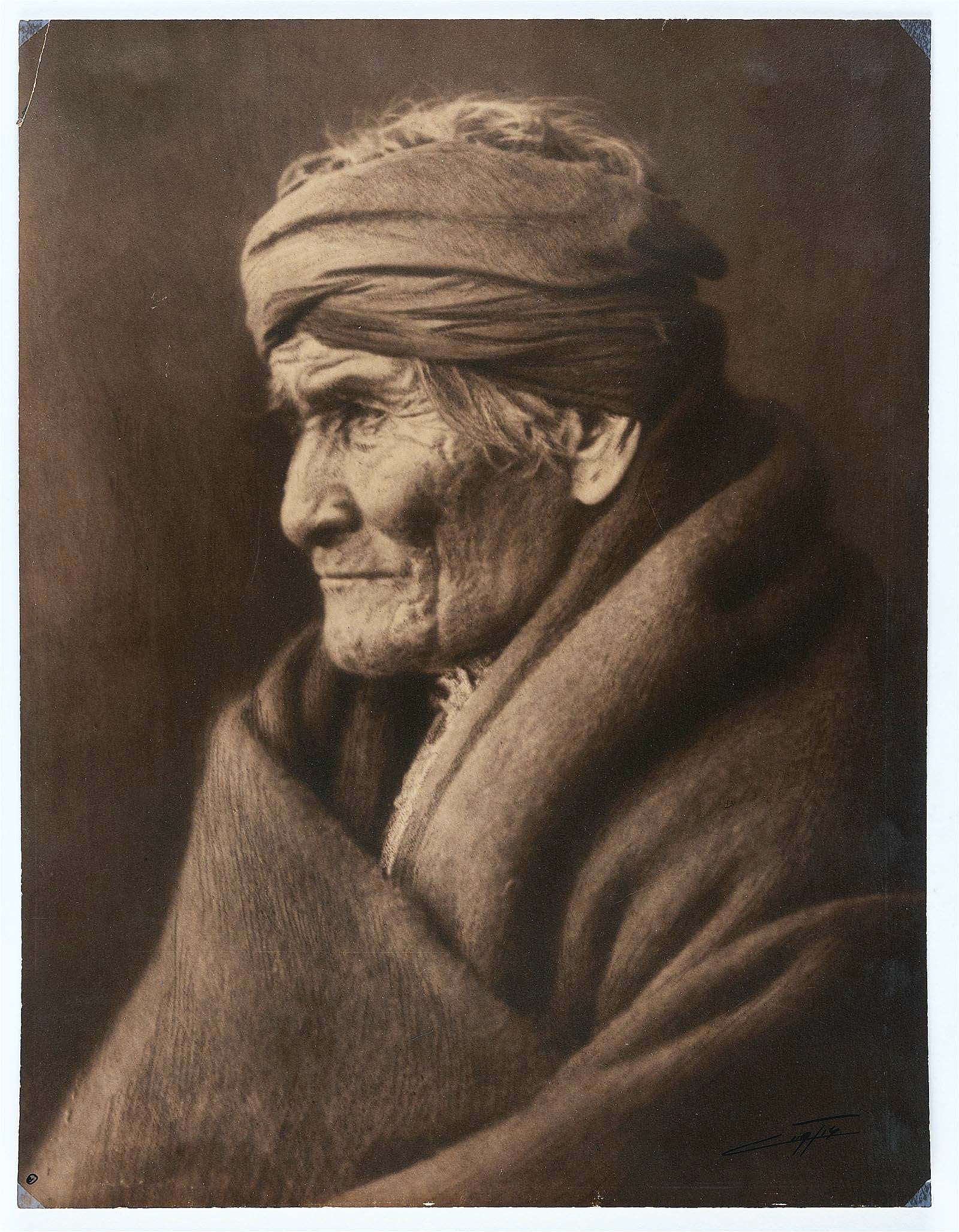
Geronimo (Apache), photographed by Edward S. Curtis (American, 1868-1952) in Carlisle, Penn., the day before the 1905 inauguration of President Roosevelt, silver print on paper, 13-5/8 by 10½ inches, achieved $14,760 ($5/8,000).
Another photograph depicts Geronimo (Goyathlay), an Apache chief remembered for his fearless resistance to colonization by American and Mexican militaries. The 1905 portrait of the 76-year-old chief earned $14,400. A circa 1908 portrait of Medicine Crow, an Apsaroke warrior, showed the sitter wearing a hawk hide headdress, symbolic of the warrior’s protective role. Though this print was incorrectly labeled “Charlie Crazy Horse TR’s Inauguration 1905” in pencil on its reverse, it still earned $17,500.
The Steidel Collection featured a vast assortment of rare and desirable colored glass bottles, most of which were from Baltimore Glass Works, circa the mid to late Nineteenth Century. Despite the auction’s diverse offerings, only one glass piece broke into the top 16 lots. Selling for $5,100, the leading glass lot was a circa 1855 grassy yellow-green soda or beer bottle, embossed “J.M. Roseberry / & Co / Alexandria / Va.” Standing at 6-5/8 inches tall, the bottle had an applied tapered double collar mouth and indented base with an iron pontil scar.
Making $14,025, well over its $1/2,000 estimate, was an 1831 silk-on-linen needlework sampler signed by “Margareter McFarlane” of Alexandria, Va. The sampler featured an eight-line prayer above a large floral arrangement, all framed by a scrolling flower and leaf vine border.
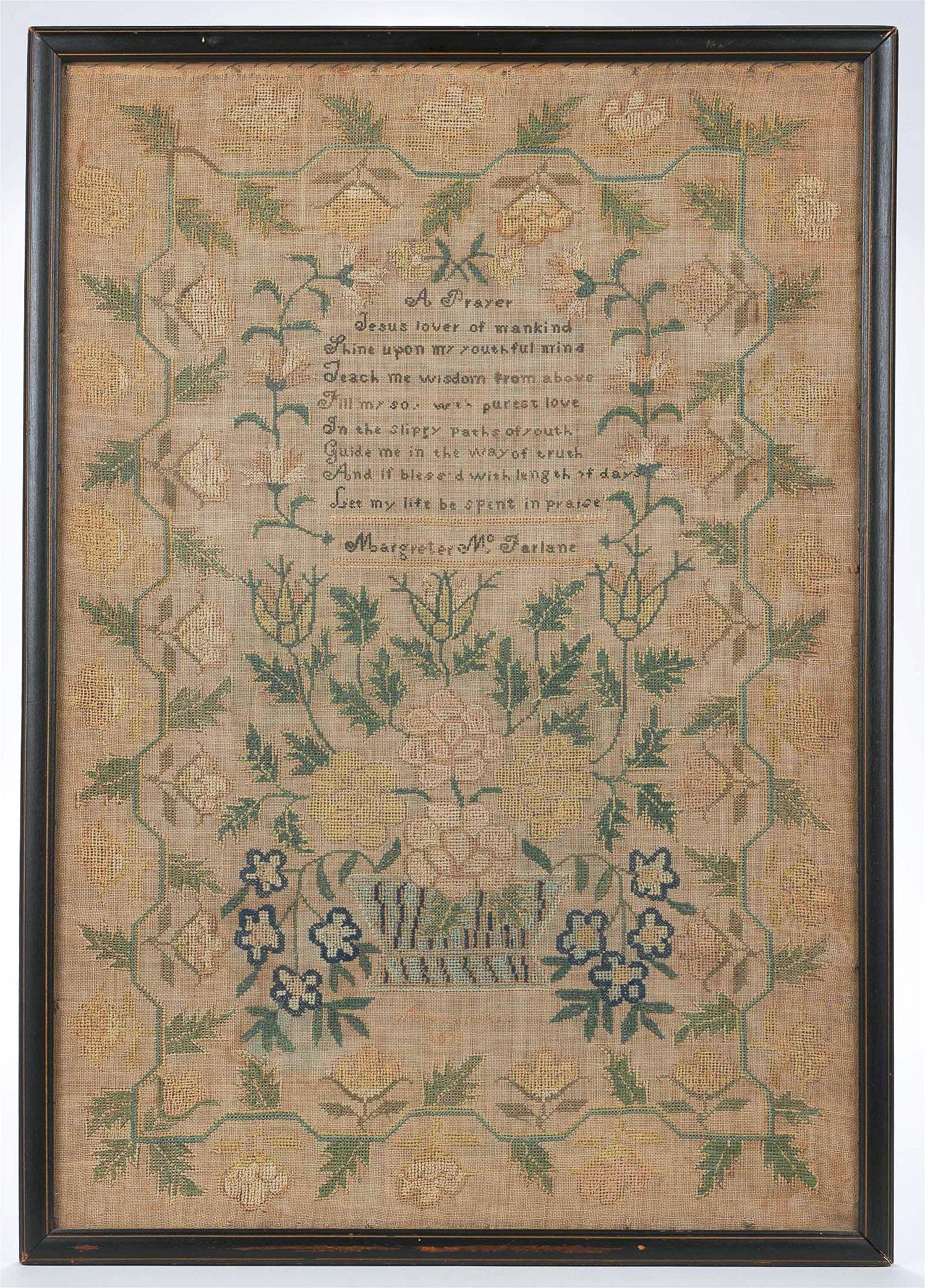
Making $14,025, well over its $1/2,000 estimate, was an 1831 silk-on-linen needlework sampler, signed “Margareter McFarlane.”
While prices on the sale’s second day were expected to be lower overall, there were a few lots that exceeded their estimates and finished among the top 16 prices for the two-day auction. Only the first four of five total volumes of Dr John Edwards Holbrook’s North American Herpetology; or, a Description of the Reptiles Inhabiting the United States were offered in the sale. Published in Philadelphia by J. Dobson in 1842, the extended second edition of Holbrook’s resource included a fifth book. Though it was missing the final volume, this set stretched to $6,150.
A vintage Italian diver’s helmet in very good overall condition, with minor scattered wear, discoloration and denting from use and age. With an applied “Salvas” plaque, the helmet dated to the first half of the Twentieth Century and brought $5,938 — nearly 20 times its high estimate.
Another stunning result from day two was that of a stylized circular wrought iron rotating broiler or gridiron, likely from a Kentucky maker, circa the late Eighteenth or early Nineteenth Century. The 23½-inch-long fireplace accessory had three simple feet and a straight handle with a curved hook for hanging. Bidding was hot and brought the final price to $5,100 against a modest estimate range of just $300/500.
Prices quoted include the buyer’s premium as reported by the auction house. Jeffrey S. Evans’ next sale, Winter Americana, will take place March 15-16. For information, 540-434-3939 or www.jeffreysevans.com.




















